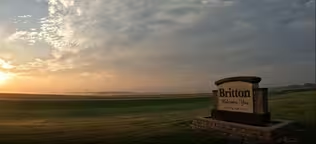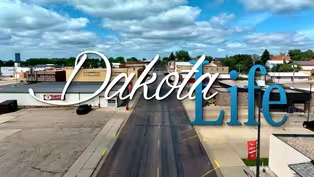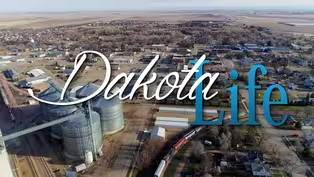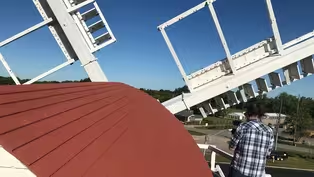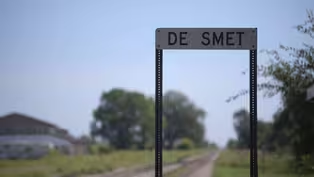Dakota Life
Greetings From Leola
Season 25 Episode 2 | 28m 12sVideo has Closed Captions
Greetings From Leola
In the October episode, we travel to Leola, where we meet a model train collector, play cards at a local card club, visit a thriving local cattle ranch and learn how the community rallies to restore a local church.
Problems playing video? | Closed Captioning Feedback
Problems playing video? | Closed Captioning Feedback
Dakota Life is a local public television program presented by SDPB
Support Dakota Life with a gift to the Friends of Public Broadcasting
Dakota Life
Greetings From Leola
Season 25 Episode 2 | 28m 12sVideo has Closed Captions
In the October episode, we travel to Leola, where we meet a model train collector, play cards at a local card club, visit a thriving local cattle ranch and learn how the community rallies to restore a local church.
Problems playing video? | Closed Captioning Feedback
How to Watch Dakota Life
Dakota Life is available to stream on pbs.org and the free PBS App, available on iPhone, Apple TV, Android TV, Android smartphones, Amazon Fire TV, Amazon Fire Tablet, Roku, Samsung Smart TV, and Vizio.
Providing Support for PBS.org
Learn Moreabout PBS online sponsorshipMore from This Collection
Dakota Life stories from towns in northeast South Dakota
Video has Closed Captions
Visit Britton and learn about people who do good in this Marshall County town. (29m 45s)
Video has Closed Captions
Milbank is a vibrant community on the eastern edge of South Dakota’s glacial lakes (26m 58s)
Video has Closed Captions
Travel with us to Desmet, Arlington, Viborg, the Black Hills and Clear Lake. (28m 15s)
Providing Support for PBS.org
Learn Moreabout PBS online sponsorship- This is a production of South Dakota Public Broadcasting.
(soft music) - In the Annals of South Dakota State's fairly self-explanatory Eminent Farmer Program, there's a short biography of the 1970 honorary.
Albert Halfa was born in Chicago and raised by extended family after losing both parents at a young age.
He was working in a blueprinting business when at the age of 17, he decided Winnipeg was the place for him.
He left Chicago, but only made it as far as Leola, South Dakota.
That was in 1914.
About 500 people lived in Leola then reaching a peak of 900 at the time of the 1960s census.
Halfa worked at an uncle's farm for a while, long enough to meet and marry Elma.
Shortly after, Albert and Elma Halfa began their own operation.
And the record shows that he became active in rural affairs because he felt his fate was tied up in the prosperity of the community.
You know, there's something timeless about that sentence, found in a dusty record from an award given 50 years ago.
Something that has to do with the communal ethos that small towns like Leola can offer.
A community spirit strong enough to change the life of an orphan from far away Chicago.
The community ethic propelled Halfa to leading roles in the South Dakota Wheat Growers Association, the National Rural Electric Cooperative Association, and a Governor's Comprehensive Health Committee among many others.
He had a chance to talk with presidents, John F. Kennedy and Lyndon Johnson on the topics of rural electrification and national resource problems.
Elma and Albert also raised three children on that farm and Albert did finally pay that visit to Winnipeg, some 30 years after that initial attempt.
Today, there are slightly fewer people in Leola than there were when Albert Halfa arrived.
Agriculture has certainly changed and it's a lot harder today for a young man from Chicago to make a go of it.
But there are still newcomers arriving in Leola.
Some commuting to Aberdeen for work, some home office workers relocating here from out of state.
But whether there are old timers or new, they still enjoy a place as Leola claims, where the air is still clean, the people are still friendly, and the possibility of a good, safe and quiet life still exists.
Welcome to "Dakota Life" and greetings from Leola.
(upbeat music) - [Narrator 1] This program is made possible with your support and with corporate support from AGTEGRA Cooperative, an Ag partner that shares the values of its members.
Strong, stable, dependable, and local.
- In 1873, the Dakota Territory Legislature voted to break up the enormous Buffalo County.
It formed the now defunct Mills County as well as Beetle and McPherson counties.
The latter two, both named for Civil War Generals.
Though, General James McPherson never set foot in the Dakotas.
He was killed at the outset of a campaign in Atlanta in 1864.
We don't know much about the pre-European history of McPherson County.
There is an archeological site which documents the style of petroglyph, thought to be thousands of years old and written records of TP rings on local hilltops indicating more recent native settlement.
In 1863, General Alfred Sully's troops came through this area.
They were on their way to Fort Pierce after the battle of Whitestone Hill.
Homesteaders began to arrive in this area in 1882.
The first town was Codo, which has since vanished.
And over the years, there have been several attempts, first by Codo and later by Eureka to change the location of the county seat, but Leola has held that position since 1884.
Charles Harriet, who helped organize McPherson County and Leola was our fourth governor of South Dakota.
In the late 1800s, times were tough.
There were crop failures and a prairie fire destroyed much of Leola in 1889.
Andreas Han, a Lutheran minister was an eyewitness.
He wrote, "A hurricane like wind had raged all day and stirred up clouds of dust.
Suddenly black clouds swept past the window and turned day into night.
Terror struck as we opened the door and saw flames coming toward us in the black smoke."
Han and his wife hurried the students in their confirmation class out of the house and they huddled on the ground while the blazing heat passed overhead.
Afterward, Han remembered everything around us was as black as coal.
The air was filled with the fine ash through which we could see half the buildings of our town including our church and house in flames.
Leola came together to rebuild.
People from Aberdeen and other surrounding towns pitched into help and many of the structures that had been destroyed by the fire were soon rebuilt.
Coming up, we're going to visit with a traveling priest and his renovated church.
Play some pinochle at the local card club and learn how Layne and LeAnn Lux used grassland management to rescue their ranch.
But first, let's get aboard and see an ever changing and amazing model train set.
(soft music) - I had a train back in the forties.
Telling my age, but back in the forties, I got my first line on train and I enjoyed playing with it.
- [Narrator 2] Pete Hanke has enjoyed two lifelong love affairs.
One with his wife Judy, and an even longer one with trains.
Perhaps his love of trains was a result of his childhood memories, or maybe it was getting his first teaching job up in the hub city of Aberdeen.
- I watched the trains there a lot and I guess I just got interested in trains.
So, I have trained books.
I read up onto whom of where they started and who started them and what have you.
So, I just enjoy it.
- [Narrator 2] When he joined the military as a young man, his hobby could have become forgotten.
But in Pete's case, it was simply put on hold.
After the service, he then moved to Leola.
- And my son was a teenager at that time.
He bought me a HoH train.
And my daughters, they bought me a roll of cotton.
My wife brought me three houses in a little set.
They're on the set here.
And so, we put that under the Christmas tree.
That's where it started, and then it grew from there on.
Got to the place that the wife said, we can't have it in the living room, no more, because you can't walk.
So, I moved it from there to the basement and it kept growing each year, it kept growing.
And then finally, the wife looked at me and she said, "Hey, I can't get to the washer and dryer, no more.
You're gonna have to do something."
In fact, I think the wife at that time probably wouldn't have given it to me if she'd have thought that it had come to having to move out the living room.
(laughs) - [Narrator 2] Pete's trains had grown so large by this point, that they had to be moved not only out of the basement, but out of the house completely.
- So, I had a two and a half car garage.
I backed both the vehicles out and I put it in the two and a half car garage and it kept getting bigger and bigger and bigger.
- At this point, the trains had become more than just a thing to be admired by Pete's family.
It was also gaining popularity throughout the community.
- Started showing it off when I moved it out to the garage.
Now, before that I had friends and people would come in, I'd take them in the basement and show it to them.
But actually it was open to the public when I moved it out into the garage.
- [Narrator 2] The train set up grew and more and more people came through to see it.
But then, Pete's life would change dramatically.
- Then my wife passed away eight years ago and I quit messing with it all together.
- [Narrator 2] After a while though, people in the community approached Pete about getting his trains back on track.
- But then they were gonna have rhubarbs day and they asked me if I would open up and show them again.
And I said, yes.
This used to be the old grocery store.
It came open and I rented in and moved it from the garage over to here.
And it's grown probably one and a half times again in here and it grows every year.
I tried to add something new every year.
And every year I try to do something that will be interesting to anyone that comes and sees it, both, young people and old people.
The thing of it is, believe it or not, sometimes I get a little down on myself and I'll come up here and I just start the trains up and sit here and listen to them run, watch them run.
It kind of takes all the cares away.
You know, you don't have to worry about nothing.
So, it's good therapy.
- [Narrator 2] Besides the therapy, it's not just the trains that give him so much pleasure these days.
It's the joy on visitor's faces that keeps Pete going.
- It's just does something to you to see a kid that probably he'll never own a train, can go through and enjoy it.
And it's just something that does your heart good.
- Some of the earliest settlers in Leola like Henry Molton, who built the first general store were English speakers who moved into town from the surrounding area.
They were followed soon by German speaking migrants from Russia.
Those migrants brought with them their own language, culture and spiritual traditions.
In 1906, Leola received a boost from the Minneapolis St. Louis Railway.
That depot still stands at the North Central Heritage Museum complex.
And that complex also includes a claim shanty and a country school along with a local jail.
For many years, Darrell Yoast and a crew of volunteers held an annual threshing bee.
It was reminiscent of the days when harvesting grain was really a community event.
After the turn of the century, better times in Leola led to growth.
New buildings went up like the 1903 Bank of Leola building.
It's now been transformed into the old bank lodge and offers accommodations and guided pheasant hunting.
In 1959, another fire destroyed several downtown landmarks, including the Molten Elliot Building.
That was one of the few that survived that fire in 1889.
But again, the town rallied to rebuild.
Just down the street from city center people, many of which have a grasp of local history, get together in a humble but comfortable space to catch up on local events and play a hand or two.
Now let's deal you in to the local card club.
(indistinct chattering) - Let's play one.
- Okay.
(indistinct chattering) - Back in 1964, and I knew we were playing at that time in the old pool hall and that went on for quite a few years until the pool hall eventually got tore down or was no longer used.
And they, four old gentlemen went and bought a building across the street and they called it the hunker.
And it ran that way for a number of years until, well, three of the four died off.
And they said, well, they're gonna get rid of that building.
So, they got rid of that building.
Well, then Ron Capas, he kind of the ram rod of this group here to kind of make sure we got a space.
He found this place for us over here and that's been running here since.
- Club Close.
- Yeah, I better do that.
(indistinct chattering) - I don't have anything.
- I have nothing.
- [Narrator 3] The group played four handed today because that's how many showed up to play, but five handed or cutthroat is the favorite game at the Leola Card Club.
- Try and set the bidder.
You wanna try and win the game, but you also want to try and set the bidder, so you don't play to take every trick.
You may skip it and let the next guy around closer that would have a better shot at setting the bidder take the trick.
- I have two hearts.
- He's not that good.
He's just lucky.
(laughs) - [Narrator 3] Every player here shares the love of the game, but for their own reasons.
- I come up here just for the bs, you know, because that's how you find out what's going on in the rest of the world.
- Don't we think there's a little bit of a passion, you know, to play?
I like it.
I do.
- And there is a thing of competition.
You'll like to be able to, you know, just be able to beat four guys.
Say, Oh yeah, I played four today.
Usually, it doesn't happen but, you know.
- It's fun when somebody get, somehow you get something up on him and everybody's picking on it.
(laughs) Poor guy doesn't have a chance the rest of the day.
- If you come here to make any money here.
(laughs) - I don't think that's what it's about.
You can have a bad day though.
- [Narrator 3] Ron Kappes finishes work for the day and stops by to play.
Now, the fun begins because now, with five players, it's cutthroat time.
This is is serious business, so you better play the right card at the right time.
- Didn't you?
- Here's what's the last one.
- I like we've all had our moment when you make the wrong play and you get reprimanded.
(laughs) But there's inevitably somebody sitting at the table that has the cards against the bid and maybe the other couple guys, you know, don't know where the cards are laying quite exactly.
- Every day, Ron or myself, we get on the phone and we text message out, you know, to say, 10 people.
- [Narrator 3] The stories are the best part of the game for these guys.
The recollection of the Callus brothers helping each other out during the game, the Jim Shafer hand, which is a great hand almost, but not quite.
These are all part of the fun.
The stakes are low and some of the money goes to rent the space.
No one is getting rich.
They're just having fun.
But time is taking its toll on the Leola Pinochle Club, and new players are always needed.
- What you might put in on that program on someplace on the 'wanted' players.
(laughs) - You don't have to be good.
- Yeah - Nope.
- Just bring money.
- In the early years of Leola, a new church congregation would meet in members' homes.
Even after a church had been built, finding a permanent pastor could take some time.
One local pastor from that era said that people got goose pimples when they heard the word Dakota.
It conjured up images of sod houses, fearsome winds, and drought stricken fields.
The oldest churches in Leola include St. James Lutheran Church.
Now, that's where Andreas Han, whose confirmation class escaped the 1889 fire was the first minister.
And then St. Hyacinth's Church, which became Our Lady of Perpetual Help in the early 20th century and moved to its present location in 1916.
Couple of interesting things about that parish.
It's one of three churches that Father Tim Cone hears confessions and says mass at each weekend.
The parishes include Ipswich, Roscoe, and here in Leola.
Father Cone is new to this three church circuit.
But in a sense, Our Lady of Perpetual Help is new again too.
- [Mary Schaunaman] In 2018, we had some wiring upgrades that we had to do, and when the electricians got above the fall ceiling, the grid actually fell down in the sanctuary and so then we had to quickly repair that and we knew at that time that we had to do something.
- Mary Schaunaman is parish council president.
The choice was to either repair a 100 year old building or do a complete restoration.
- We decided that we needed to go ahead and do the restoration and so, we started a capital campaign to reach our goal and within six weeks, we had 80% of our goal reached.
And at that time, I believe that was around March of '21, we got the okay from Bishop Tugru to go ahead and proceed with the restoration because we had collected that much money.
- [Larry Rohrer] And then the pandemic stopped the project in its tracks.
So, during that time, the council under the guidance of then parish priest, Father Timothy Smith, arranged for a contractor and all the subcontractors and in January, 2022, work began.
- Father Smith worked tirelessly to get this going and the bishop was in agreement because we were able to raise that money so fast.
And I think all the parishioners were committed to it.
So, I think it was a good sign that we wanted to have it done.
- [Larry Rohrer] Services were held in the parish hall as the building was stripped to the studs, modernized and rebuilt.
The project also confirmed the congregation's commitment to each other.
- [Mary Schaunaman] I think as a whole, our group has been really good.
Anybody that was asked to do anything, there was never a no.
It just, they came ahead and did it.
We're a farm community, so these people are busy.
So yeah, so it's been great.
- [Larry Rohrer] One major change order along the way near the end of the restoration, Father Smith moved to Windom, Minnesota and Father Tim Cone arrived.
But not just in Leola.
That's the second part of our story how a parish priest divides his time between three communities that are an 80 mile round trip.
- Yeah.
all right.
(laughs) (indistinct chattering) - As time has gone on, just the number of priests have gone down as well as the shifting demographics in the rural communities and stuff.
So many people move into to the cities.
It's just happening much more now than than ever before.
- [Larry Rohrer] And even more so in surrounding states.
But even though the week is driven by specific times for mass and confessions, the rest takes planning and the right frame of mind.
- [Father Tim cone] Yeah, I don't have an office in each locations, so I'm gonna take what I need with me to each of these locations.
And so, just much more preplanning on my part.
But one of the benefits of it is I actually enjoy screentime or windshield time, you know, because that's a chance for me just to, honestly, I end up praying during most of that time, spending time with our lord, kind of checking it.
- [Larry Rohrer] This is farm country, so the distances are not surprising.
What is, is the way Father Cone of City Boy has embraced it.
- I've been so surprised by these smaller communities.
I mean, just, number one: their love for their faith.
I mean, like, the roots run deep here.
Those who live by the land, I'm finding more and more have such deep faith and it's encouraging to me.
I mean, I didn't grow up on a farming, I am the city guy.
And then, just to see the faith of those from Leola, it's beautiful.
I mean, this is a parish named after our blessing mother and they absolutely love our blessing mother.
So just, it's encouraging to see that for me personally.
- [Larry Rohrer] And less than nine months after construction started, the parishioners of our Lady of Perpetual Help celebrated a restoration mass.
- It's beautiful.
(laughs) I mean, it's absolutely beautiful.
And to see people, they're so excited to get back into their church.
I mean, this is where so many of them grew up, this is where they were baptized, this is where they received all their sacraments.
It means so much to them, and it's so to have it put back to its original splendor and glory.
It's amazing.
- Agriculture has always been the heart of Leola's economy.
And though the town is known for its annual festival, celebrating it as the rhubarb capital of the world, you might be surprised to hear that farmers around here produce more corn than rhubarb.
Well, before it was corn, wheat was the dominant crop.
That's what Darrell Yoast and others learned to reap and thresh in the days when combines were not near as common.
With wheat prices rising, who knows?
You may see it back in the fields again.
Another change has been the decline in dairy farms.
Layne and LeAnn Lux were among those local dairy farmers struggling to get by, but the Lux ranch has held on through sheer determination and creative grassland management.
- [Narrator 3] In the mid 1990s, McPherson County was home to more than 30 small dairy farms.
Today, there is one left.
Layne and LeAnn Lux were among the last small dairies to close.
- There were months at a time where we would work 12 to 16 hours a day and you would actually go backwards.
You would lose money.
- [Narrator 3] Determine not to lose their farm to debt from low milk prices and high feed cost, in 2008, the couple sold their 60 dairy cows and turned their attention to raising beef cattle on their land near Leola.
LeAnn said it was not a difficult decision to transition from dairy farming to cattle ranching, because from the start, their goal was to own land and livestock.
So, there are five children could grow up like they did.
- There isn't a better place to raise a family than out in the country.
They have a good work ethic.
They learn a ton about just nature, unfortunately life and death.
But it's all lessons that they can take with them for the future.
- [Narrator 3] With their focus on beef cattle, the couple began maximizing their forage production by implementing grassland management strategies.
- Our grazing program, what we usually try to do is move the cattle throughout various pastures throughout the season so they'll graze the one area and a lot of times we won't go back there for a year, year and a half, so that grass grows up again.
- [Narrator 3] The couple closely monitor their cattle's grazing to ensure they do not overgraze any one area.
- So, if you keep, you know, some leaf on the grass that it has chance for photosynthesis and everything, it comes back, it recovers easier.
The roots have a better chance of going down deeper, which then you don't need as much moisture to sustain it.
- [Narrator 3] Since 2016, LeAnn has been managing the day to day ranch activities full time, while Layne worked off the ranch during the work week to provide supplemental income.
She says that during a growing season, like 2022, rotational grazing does not require too much effort.
But during a drought year like 2021, it takes careful planning.
- You know, last summer, we spent a lot of time moving cattle from one pasture to another.
But once they got to kind of know that when you came out to the pasture with four wheelers then they were getting to a new area of grass.
A lot of times you could just call them and they would know where the gates were because they've been rotated through them enough.
- [Narrator 3] Watching cattle graze this summer, Layne says the grasslands look much different.
- I mean last year, everything was brown and almost gone and this year, you come out and half the time you can't see the cows.
Or you can't see their calves for sure, because the grass is so tall out here.
So yes, definitely from a drought to a very wet spring.
The wet spring was a double edged sword.
It was tough calving season.
And with all the storms and everything going on, the cold weather, we normally don't check the cows at night, but this year, we had to each, jump on a four wheeler and drive through 200 acres of pasture.
We had flashlights trying to find, you know, see if cows were calving, see if a calf was down.
That was getting too cold.
And then we'd come in and I'd sit in my chair, LeAnn would lay on the couch, we'd sleep for two-three hours, set the alarm and go out and do it again and drive through them again to make sure that there was nothing in distress.
- [Narrator 3] After many sleepless nights and endless storms, calving season 2022 also marked Layne's returned to work full time on the ranch with LeAnn.
It's a decision they are both happy about.
- That community spirit embodied by Albert Halfa, the Chicago orphan turned eminent farmer or by Darrell Yoast's threshing bees.
It's still alive and well in Leola.
Look no further than the Piggy Bank Thrift Shop.
Keenan Stacker, known in Leola as a volunteer extraordinaire, thought the town needed a vehicle for raising funds for those in need.
So, he applied for a grant and that along with the help from many other local volunteers, established an independent, not for profit thrift shop.
And who does it help?
Well, it helps anybody who asks, says Decker.
You know, over the years, Leola has faced challenges of rising and falling population numbers, droughts, fires, and even floods.
But the guiding beliefs and ideals of community as demonstrated by Albert Halfa, Keenan Decker, and many more, as long as that survives, it seems so will Leola.
You can revisit all of our stories about Leola and the other communities.
We visit at www.sdpb.org/dakotalife.
Thanks for coming along with us to McPherson County.
I'm Larry Rohrer.
For all of us at SDPB, thanks for watching.
Support for PBS provided by:
Dakota Life is a local public television program presented by SDPB
Support Dakota Life with a gift to the Friends of Public Broadcasting
